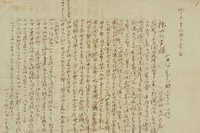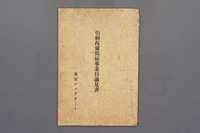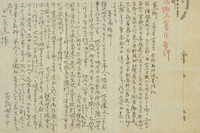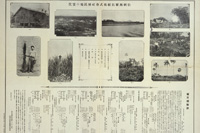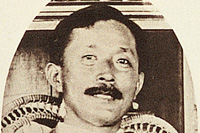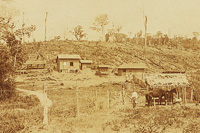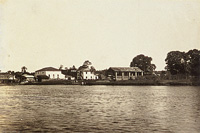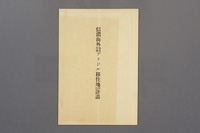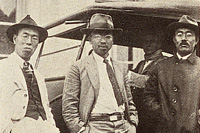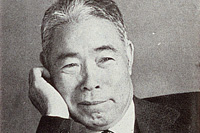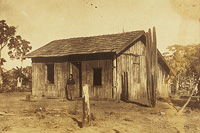Iguape Colony
Tokyo Syndicate
In contrast to the Hirano Colony and Cotia Village, which were formed by emigrants who used to be a coffee picker and had ran away from coffee plantations, the Iguape Cologne was constructed with funds provided from Japan.
In 1910, Ikutaro Aoyagi got financing from the then Minister for Agriculture and Commerce, Kanetake Oura and other project supporters and took a voyage to Brazil. Aoyagi inspected the State of São Paulo and the three other southern states, and after determining that the Iguape region in the Ribeira River Basin 160km west of São Paulo City would be the most suitable land for the establishment of a colony, applied for a gratuitous grant of land from the State Government in the name of the "Tokyo Syndicate", a joint cooperative formed for the purpose of establishing a colony.
After the State Legislature passed an act authorizing the State Government, the State Government and the Tokyo Syndicate entered into the agreement on March 8, 1912 which prescribed that the State should grant gratuitously 50,000ha of uncultivated land in the Iguape region to the Tokyo Syndicate in order to build a Japanese colony and that the Tokyo Syndicate should attract and settle 2,000 Japanese families in the colony within 4 years.
Establishment of the Brazil Colonization Company and construction of the Katsura Colony
In March 1913, with the support of the then Prime Minister, Taro Katsura, the Brazil Colonization Company was founded (with an initial capital of 1 million yen) with Eiichi Shibusawa as chairperson and the company took over the agreement from the Tokyo Syndicate. In September of the same year, the Brazil Colonization Company received a gratuitous grant of 1,400ha of land in the Gipuvura region located on the left bank of the Ribeira River with a commitment to settle thirty families in the region, and began building a colony. The colony was named the "Katsura Colony" in honor of Prime Minister, the late Taro Katsura. At first recruitment for 30 families was carried out in the outlying areas of the State of São Paulo in vain and then was carried out in the Rua Conde (Conde Street) area where many Japanese immigrants lived, The first settlers arrived from November to December of the same year.
-
Books
-
 Actual situations of the Brazil Colonization Company colonies
Actual situations of the Brazil Colonization Company colonies -
 Ikutaro Aoyagi
Ikutaro Aoyagi
Establishment of the Registro Colony
Afterwards, the Brazil Colonization Company sought to secure lands in the Registro region located up the Iguape River from the Katsura Colony. But the land which the company had believed to be unsettled (state-owned) was found to actually include privately held land and land occupied by prior settlers, therefore it took time and patience to clear encumbrances of the land. In addition it was found necessary to raise additional investment from stakeholders, which also took time and patience. Recruitment for 300 independent farmer families in Japan began in June 1916 and by August, the company managed to secure approximately 9,300ha of land. But since only 4 families applied to the recruitment although three emigration companies were contracted to recruit, the first recruitment met with failure. Thereafter 99 families, however, were recruited in 1917, 150 families in 1918.
In 1919, the Brazil Colonization Company merged with the Kaigai Kogyo Kabushiki Gaisha (Overseas Enterprise Company Limited) and the rights for operating the Iguape Colony passed to the Kaigai Kogyo Kabushiki Gaisha (Overseas Enterprise Company Limited). From around 1920, the company began work on building a new colony up the Ribeira River in Sete Barras.
The Iguape Colony originally focused mainly on rice cultivation, it later, however, expanded to production of sugar cane and coffee as well as silk farming. From the 1930s onwards, the cultivation of the production of tea (black tea) began to flourish in the colony.
-
Articles in newspapers / magazines
-
 Registro Colony
Registro Colony -
 Panorama of Registro
Panorama of Registro
Alianca Settlement
Shinano Kaigai Kyokai’s plan to establish a settlement
On January 29, 1922, through the good offices of Shigeshi Nagata of the Nippon Rikkokai and Shungoro Wako who had temporarily returned home from Brazil, Tadahiko Okada (the then Governor of Nagano Prefecture), Gosuke Imai (Member of the House of Peers) and Heikichi Ogawa (Representative from Nagano Prefecture, Seiyukai Party) became promoters and the Shinano Kaigai Kyokai (Shinano Overseas Society) was founded as an organization to promote overseas emigration of Nagano Prefecture inhabitants.
On May 13, 1923, Toshio Honma, the then governor of Nagano Prefecture, summoned the directors of the Shinano Kaigai Kyokai (Shinano Overseas Society) as well as the heads of all the districts and the cities in the prefecture, and announced the construction of the "perfect settlement" in Brazil "where immigrants would settle safely and surely, not feel threatened in any way, become such large a landowner as they could not wish to be here in Japan and find the same degree of happiness as in their home", based on the plan which Wako submitted before he returned to Brazil in March of the previous year to construct a 5,000ha settlement at the total expense of 200,000 yen.
Construction of the Alianca Settlement
In May 1924, the Shinano Kaigai Kyokai (Shinano Overseas Society) solicited Tetsusuke Tarama, Consul in Bauru to select candidate sites with the survey expenses which the society sent him. The Consul entrusted Wako with the selection, who acknowledged 5,525ha of land (the first Alianca Settlement) situated near Lussanvira station on the Noroeste railroad as suitable. Nagata was dispatched from Japan and concluded a purchase agreement in October of that year, and receiving a government grant for a voyage, immigrants started to settle from Japan and North America in June 1925. All of the lots in the settlement were sold out.
Afterwards, the Shinano Kaigai Kyokai (Shinano Overseas Society) acquired additional land adjacent to the Alianca Settlement in August 1926 and February 1927, and also recommended that the Tottori Ken Kaigai Kyokai (Tottori Prefecture Overseas Association), the Toyama Ken Kaigai Imin Kyokai (Toyama Prefecture Overseas Migrant Association) and the Kumamoto Ken Kaigai Kyokai (Kumamoto Prefecture Overseas Association) purchase land around Alianca (the second Alianca settlement, the third Alianca settlement and the Vila Nova).
Many of the Alianca settlers had quite a bit of assets and they were relatively highly educated, which made them unique among immigrants. It is said that some of the settlers even brought pianos and books with them. Since earlier coming immigrants thought that the newcomers "had indulged in the so-called cultural lifestyle" such as "Gin bura" (wandering along the streets in Ginza that was a modern shopping area in the heart of downtown Tokyo) and a primitive way of life had attracted them, they made fun of the newcomers by called them "Ginbura imin".
-
Books
-
 Plan for the establishment of a settlement in Brazil belonging to the Shinano Kaigai Kyokai (Shinano Overseas Society)
Plan for the establishment of a settlement in Brazil belonging to the Shinano Kaigai Kyokai (Shinano Overseas Society) -
Books
Records of settlement land purchases (Shigeshi Nagata's memoranda)
-
 (Left ) Settlement director Shungoro Wako, (Center) settlement director Chikazo Kitahara, (Right) settlement supervisor consul Tetsusuke Tarama
(Left ) Settlement director Shungoro Wako, (Center) settlement director Chikazo Kitahara, (Right) settlement supervisor consul Tetsusuke Tarama
-
 Shigeshi Nagata
Shigeshi Nagata -
 Alianca Colony
Alianca Colony -
Original materials
Articles in newspapers / magazines

